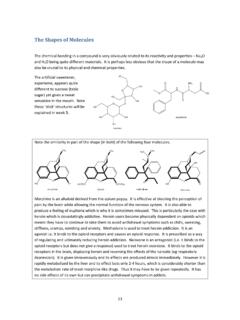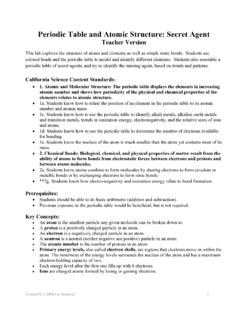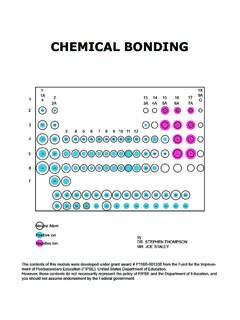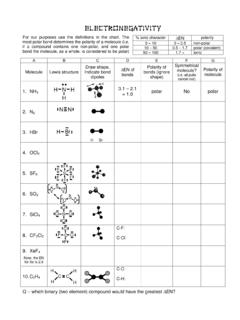Search results with tag "Electronegativity"
Periodic Trends Multiple Choice Review PSI Chemistry Name
content.njctl.orgJul 13, 2012 · Electronegativity 23)The ability of an atom in a molecule to attract electrons is best quantified by the _____. A) paramagnetism B) diamagnetism C) electronegativity D) first ionization potential E) electron change-to-mass ratio 24)Electronegativity _____ from left to right within a period and _____ from top to bottom within a group.
Chapter 9 Bonding 2 Polar Covalent Bond, Electronegativity ...
drsapnag.manusadventures.comPolar Covalent Bond, Electronegativity, Formal Charge, Resonance Dr. Sapna Gupta. ... Resonance is the movement of electrons over two or more bonds. In these cases ... Example: NO 2 Dr. Sapna Gupta/Bonding 10. Key Points •Lewis structures •Bond polarity •Electronegativity •Formal charge •Resonance structures Dr. Sapna Gupta/Bonding 11 ...
Shapes of Molecules - The University of Sydney - One of ...
www.sydney.edu.austructure, and then apply the VSEPR model. CH 4 Geometry = CH 3 – Geometry = NH 4 + Geometry = NH 3 Geometry = NH 2 – Geometry = H3O + Geometry = H2O Geometry = Dipole Moments Any bond between atoms of different elements will be polar as a result of the electronegativity difference between the atoms. A molecule has a permanent dipole moment ...
Periodic Table and Atomic Structure: Secret Agent
labsci.stanford.eduand transition metals, trends in ionization energy, electronegativity, and the relative sizes of ions and atoms. • 1d. Students know how to use the periodic table to determine the number of electrons available for bonding. • 1e. Students know the nucleus of the atom is much smaller than the atom yet contains most of its mass. • 2 ...
B.Sc. - FIRST YEAR
mjpru.ac.incharge. II. Periodic Properties: Atomic and ionic radii, ionization energy, electron affinity and electronegativity- ... characteristics of covalent bond, various types of hybridization and ... stability and carbon-carbon bond lengths of benzene, resonance structure, MO …
Chemical Bonding - Colorado State University
www.smallscalechemistry.colostate.eduwhen there is a large difference in electronegativity. Ionic Bonding In COVALENT BONDING the valence electrons are shared as pairs between the bonded atoms. Pure covalent bonding only occurs when two nonmetal atoms of the same kind bind to each other. When two different nonmetal atoms are bonded or a nonmetal and
Electronegativity - Dipole, VSEPR Shape, Symmetry, Polarity
www.chalkbored.comelectronegativity . For our purposes use the definitions in the chart. The most polar bond determines the polarity of a molecule (i.e. if a compound contains one non-polar, and one polar






